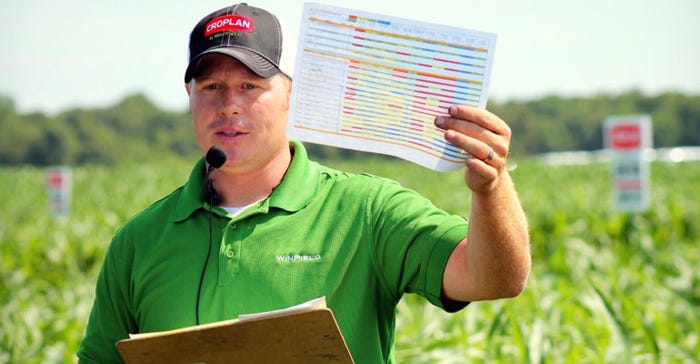November 27, 2017

By Jon Zuk
Take some of the indoor time that winter offers to map out your 2018 nutrient management strategy. Doing so will help ensure you’re properly nourishing your hybrids from the start of the season through all critical growth stages.
Here are five tips to help get your corn plant nutrition program off to a strong start.

PLANNING TIME: The winter season is a good time to review crop data and plan your nutrient strategy for the upcoming growing season. (Photo courtesy of WinField)

1. Ensure proper hybrid placement. The first step to setting plants up for success is getting hybrids placed correctly. For example, pinpointing the right soil type for the root structure a particular hybrid needs is critical to ensuring nutrients can get into the plant. Work with your agronomist to identify hybrid-specific data, including response to soil type, response to nitrogen, response to crop rotation and response to population, to place hybrids appropriately.
Also, look at the emergence scores for the hybrids you’ve chosen. If you like to plant early, it is important to choose a few hybrids with strong emergence scores that can maintain vigor throughout Minnesota’s variable early-spring conditions. Come spring, start planting the hybrids with higher scores for early emergence to get your crop off to the best start.
2. Plant seed at the correct depth. Be choosy about soil conditions. I recommend planting corn at a depth of 1.75 inches. With spring temperature swings, your corn seed could be subjected to 40-degree-F temperature variances in that first inch of soil. Temperatures tend to be slightly more consistent below a 1-inch soil depth. Planting in proper soil conditions helps ensure ideal seed-to-soil contact, water imbibition and proper initiation of root growth.
3. Use a pop-up starter to give your plants a preemergent nutrient boost. Help encourage emergence at planting with an in-furrow application of phosphorus and zinc, combined with a plant growth regulator. Applying a PGR can help promote a larger root system for quicker and more efficient nutrient uptake, faster emergence and stronger stalks. Not just any PGR will do this trick — so be sure to talk with your agronomist about the right PGR for your fields.
4. Use hybrid-specific data and tissue sampling for in-season nutrient management. To be certain you’re getting needed nutrients into the plant from emergence through vegetative growth stages, combine in-season imagery with tissue sampling. Response to nitrogen and response to fungicide scores can also be used to determine how each specific hybrid may respond to these types of applications.
For example, if you have a hybrid that’s highly responsive to nitrogen and you’re planning to make a sidedress application, take a tissue sample to determine if there are other deficiencies such as potassium, sulfur or zinc that you can address. Correcting any deficiencies will help make your nitrogen application more efficient and optimize your overall yield potential.
5. Use precision ag to target nutrient placement. Some of the biggest gains in sustainability and yield potential come from applying nutrients closer to the time crops use them. Using soil samples, past yield maps and in-season imagery can identify areas where yield potential may be falling behind or poised to increase. After that, well-timed tissue and soil sampling can indicate key nutrient levels, so you know exactly how much product should be applied — and where and when. This helps reduce overfertilization and nutrient runoff while helping optimize crop production. It can also save you time and money on nutrient and application costs.
Use these tips and the tools available to make informed in-season nutrient management decisions. Talk with your local agronomist about putting similar practices to work in your fields.
Zuk is a regional agronomist with WinField United in southern Minnesota. Contact him at 507-259-5168 or [email protected].
You May Also Like




